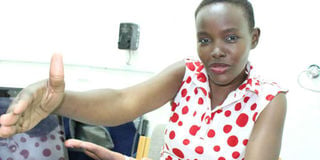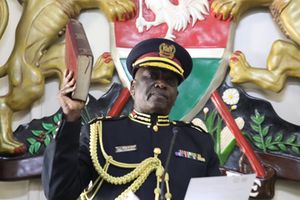Nurse proves one can live life to the full with sickle-cell anaemia

Ms Roselydah Oloo gestures during an interview at Jaramogi Oginga Odinga Hospital in Kisumu County. She suffers from sickle-cell anaemia. PHOTO | COURTESY
What you need to know:
- The 31-year-old nurse said the condition is shrouded in myths, many of which she has proved to be just that: myths.
- According to the World Health Organization (WHO), sickle-cell disease is a genetic disorder.
With charming confidence, Ms Roselydah Oloo asserts her presence at the Oncology and Palliative Care Unit of Jaramogi Oginga Odinga Hospital, Kisumu County.
A captivating smile lights her smooth face, camouflaging the trials and tribulations of more than three decades.
“I have dismantled myth after myth of sickle-cell anaemia and I’m living proof that one can live with the condition and be successful,” Ms Oloo said.
DISMANTLING MYTHS
The 31-year-old nurse said the condition is shrouded in myths, many of which she has proved to be just that: myths.
“People say a sickler does not live to see her 12th birthday. I’m 31 and I’m not going anywhere any time soon,” she said.
After going through school against all odds, Ms Oloo trained as a nurse at Kakamega Medical Training College.
SUPPORT FROM FAMILY
She has also proved naysayers wrong that, through interaction, one can pass on the condition.
“I learnt to view my condition not as a weakness but a blessing. However, along the way, my parents, teachers and fellow learners were very supportive,” Ms Oloo said in an interview in her office at the hospital.
The third-born in a family of three said it was a tall order for her parents to bring her up after it emerged, three weeks after she was born, that she was weak and would spend most of her life in and out of hospital.
"Knowing and accepting your condition is the hallmark of victory and, indeed, I’m what I am because of that. I battled for 13 years to accept my situation,” she said.
RED BLOOD CELLS
The author of Living With Sickle Cell Anemia: My Life As a Sickler, which she wrote at the age of 25, has studied widely about the disease and learned to live with it.
“Sickle-cell anaemia is a condition in which a mutated form of haemoglobin distorts the red blood cells into a crescent shape, which lowers oxygen levels in the blood,” Ms Oloo explained, adding that this forces the body to overwork and adjust accordingly.

Ms Rosepydah Oloo displays a copy of her book titled Living With Sickle Cell Anemia: My Life As a Sickler. PHOTO | COURTESY
According to the World Health Organization (WHO), sickle-cell disease is a genetic disorder whose recurrent pain and complications can interfere with many aspects of the patient’s life — including education, employment and psychosocial development.
“The drugs used by sicklers are very expensive and my dream is to see this change," Oloo, who has been on medication all her life, said.
POVERTY
A daily dose for an adult can go for an average of Sh100 while for a minor it is relatively higher.
“The condition is, indeed, a big problem, especially to poor households, because the patient needs regular check-ups, alongside the drugs,” said Ms Oloo.
Her mission now is pooling resources to print 10,000 copies of her book, ensure it is sold far and wide and then use half of the royalties to buy medicines for sicklers who cannot afford them.
“I stopped thinking of asking the government to do this or that. I can do something to touch a life or two.
"However, the government should make it easier for sicklers to access the drugs."
HEREDITARY
Ms Oloo, who said she is writing her second book, added: “We have clinic days for our chemotherapy patients and, when they are not here, I use that time to write and prepare presentations for my advocacy work.”
Her greatest joy is talking to parents of sicklers and reassuring them that their children have a chance to live and prosper.
"When I meet the mothers, I see desperation in their eyes. But with time, they get reassured," she said.
The condition is hereditary.
"In our family there are a number of sicklers. All a parent need do is accept that they have a weak child and support them to live their life."
SINGLE LIFE
Some of the challenges manifest during puberty, she added.
“They also say that sicklers don’t marry. Maybe this is partly true because I am 31 and single. But I’m proud of my status," she said.
Most sicklers find it hard to disclose their condition to suitors, she added, while others miss out altogether once they do.
PEOPLE AT RISK
WHO says about five per cent of the world’s population carries traits for haemoglobin disorders, mainly sickle-cell disease and thalassaemia.
These are genetic blood diseases due to inheritance of haemoglobin genes from both, generally healthy, parents.
An estimated 300,000 babies with severe haemoglobin disorders are born every year.
“The health burden of haemoglobin disorders can be effectively reduced through management and prevention,” the agency writes.
AWARENESS
In 2008, the United Nations General Assembly designated June 19 as the World Sickle-Cell Day to create awareness of the condition, which has become foremost and widespread.
This year, the national event will be held in Mombasa.
“We need to ensure myths and stigma associated with sickle-cell disease are removed,” Ms Oloo said.




